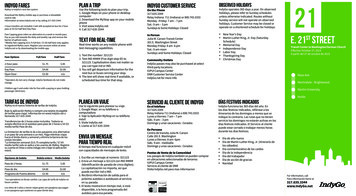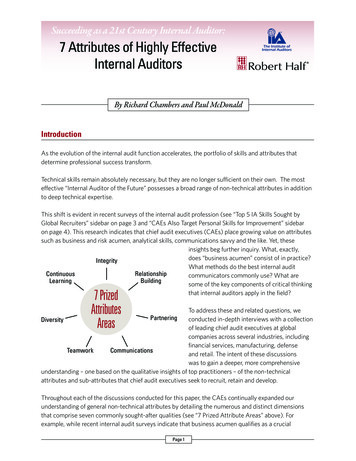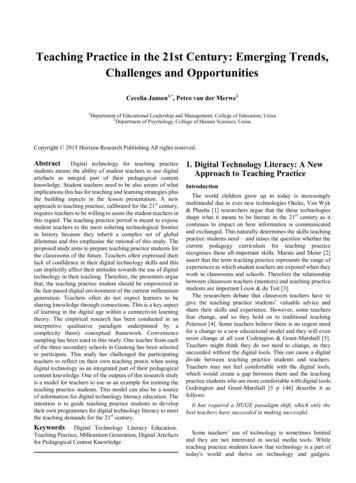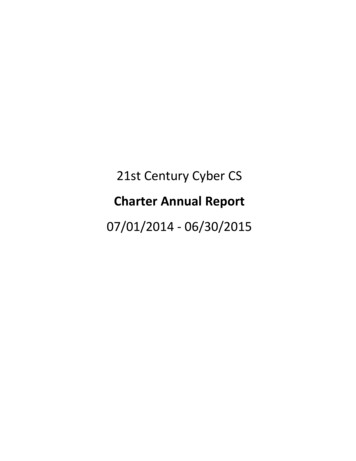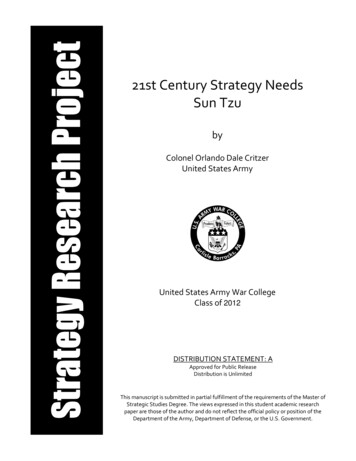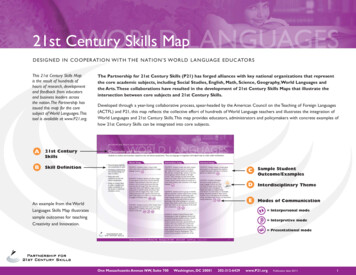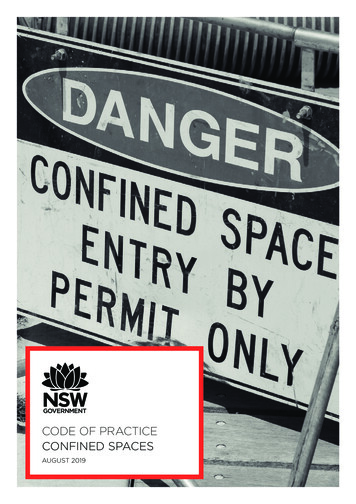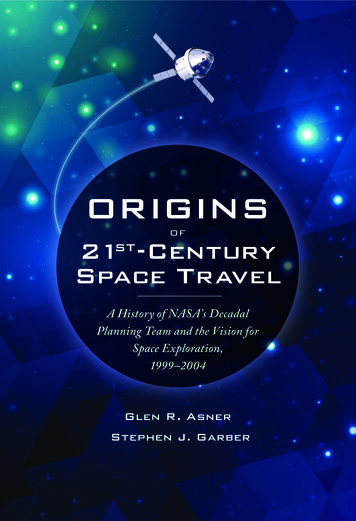
Transcription
ORIGINSof21st -CenturySpace TravelA History of NASA’s DecadalPlanning Team and the Vision forSpace Exploration,1999–2004Glen R. AsnerStephen J. Garber
ORIGINSof21 -CenturySpace TravelstA History of NASA’s DecadalPlanning Team and the Vision forSpace Exploration, 1999–2004The Columbia Space Shuttle accident on 1 February2003 presented the George W. Bush administrationwith difficult choices. Could NASA safely resumeShuttle flights to the International Space Station? Ifso, for how long? With two highly visible Shuttle tragedies and only three operational vehicles remaining,administration officials concluded on the day of theaccident that major decisions about the space program could be delayed no longer.NASA had been supporting studies and honingplans for several years in preparation for an opportunity to propose a new mission for the space program.As early as April 1999, NASA Administrator DanielGoldin had established the Decadal Planning Team(DPT) to provide a forum for future Agency leaders tobegin considering goals more ambitious than sending humans on missions to near-Earth destinationsand robotic spacecraft to far-off destinations, withno relation between the two. Goldin charged DPTwith devising a long-term strategy that would integrate the entire range of the Agency’s capabilities, inscience and engineering, robotic and human spaceflight, to reach destinations beyond low-Earth orbit.When the Bush administration initiated interagency discussions in 2003 to consider a newspaceflight strategy, NASA was prepared with technical and policy options, as well as a team of individuals who had spent years preparing for the moment.Although elements of the policy that President Bushannounced at NASA Headquarters in January 2004,the Vision for Space Exploration (VSE), differedfrom the plans developed by DPT and its successor,the NASA Exploration Team (NEXT), the benefits ofpreparation were unmistakable.continued on back flap
continued from front flapFrom the moment President Bush announcedthe VSE, NASA stood ready to implement it. Keydecisions, such as setting a termination date forShuttle flights and initiating the development oftechnologies for deep space exploration, heraldeda paradigm shift, allowing both NASA and the U.S.space community to move beyond the infrastructure,technologies, and institutional arrangements thathad sustained low-Earth orbit operations for morethan two decades. This book provides a detailed historical account of the plans, debates, and decisionsthat opened the way for a new generation of spaceflight at the start of the 21st century.ABOUT THE AUTHORSGLEN R. ASNER is the Deputy Chief Historianfor the Historical Office, O ffice of th e Se cretary ofDefense (OSD), and general editor of the five-volumeseries History of Acquisition in the Department ofDefense. Prior to joining the OSD Historical Office in2008, Dr. Asner worked as a historian in the NASAHeadquarters History Office a nd a s t he E xecutiveSecretary for the International Space Station AdvisoryCommittee. He holds a master of science degreeand a doctoral degree, both in history and policy,from Carnegie Mellon University, along with a bachelor of arts degree in history from the University ofWisconsin–Madison. He has written on the societalimpact of spaceflight, t he o rganization o f i ndustrial research in the United States, and the historyof defense research and development (R&D) andacquisition policy.STEPHEN J. GARBER works in the NASA HistoryDivision at Headquarters. He has also served in thePentagon’s space policy office, t he C ongressionalResearch Service, and NASA’s Office o f S paceScience. He has done research and writing on a variety of history and policy issues related to civilian andnational security space policy, such as orbital debris,NASA’s organizational culture, the design of the SpaceShuttle, and the Soviet Buran Space Shuttle. He hasa bachelor of arts degree in politics from BrandeisUniversity, a master’s degree in public and international affairs from the University of Pittsburgh, anda master’s degree in science and technology studiesfrom Virginia Tech.
ORIGINSof21st -CenturySpace Travel
ORIGINSof21st -CenturySpace TravelA History of NASA’s DecadalPlanning Team and the Vision forSpace Exploration,1999–2004Glen R. AsnerStephen J. GarberNational Aeronautics and Space AdministrationOffice of CommunicationsNASA History DivisionWashington, DC 20546NASA SP-2019-4415
Library of Congress Cataloging-in-Publication DataNames: Asner, Glen R., 1970– Garber, Stephen J.Title: Origins of 21st-century space travel: a history of NASA’s Decadal PlanningTeam and the Vision for Space Exploration, 1999–2004 / by Glen R. Asnerand Stephen J. Garber.Description: Washington, DC : National Aeronautics and Space Administration,Office of Communications, NASA History Division, [2018] Series: NASAhistory series Series: NASA SP ; 2019-4415Identifiers: LCCN 2015008003Subjects: LCSH: Astronautics and state—United States—History—21st century. Astronautics—United States—History—21st century. Outer space—Exploration—Planning—History—21st century. United States. NationalAeronautics and Space Administration. Decadal Planning Team.Classification: LCC TL789.8.U5 A77 2018 DDC 629.40973/090511—dc23LC record available at https://lccn.loc.gov/2015008003ABOUT THE COVER: The background image depicting astronomical phenomenais from iStockPhoto. The image of a spacecraft is an artist’s conception of theOrion capsule, designed to carry humans into deep space, which evolved fromthe 2004 Vision for Space Exploration.This publication is available as a free download athttp://www.nasa.gov/ebooks.ISBN 978-1-62683-046-29 781626 83046290000
vCONTENTSForeword by William H. Gerstenmaiervii1Introduction12Context and Background of Exploration Planning93“Sneaking up on Mars”: Origins of the Decadal Planning Team394Change in Leadership, Continuity in Ideas835The Columbia Accident and Its Aftermath996“Bold in Vision and Cheap in Expense”1257Implementing the Vision for Space Exploration1698Conclusion189APPENDIX A A Brief Note on Sources and Acknowledgments199APPENDIX B Biographical Appendix203APPENDIX C Chronology213APPENDIX D Key Documents215APPENDIX E NASA Organizational Restructuring221APPENDIX F Acronyms225The NASA History SeriesIndex 239227
viiFOREWORDWilliam H. GerstenmaierNASA ASSOCIATE ADMINISTRATORHUMAN EXPLORATION AND OPERATIONS MISSION DIRECTORATE“Plans are worthless, but planning is everything.”—Dwight D. Eisenhower, 1957LONG-TERM PLANNING is difficult for any organization, but a government organi-zation has a special set of challenges it must deal with. Congress, which appropriates funding and dictates priorities for executive branch agencies, operateson a one-year financial cycle and a two-year political rhythm. The President, towhom all federal executive agencies are directly accountable, changes administrations once every four years, even when the President is reelected. It is againstthis backdrop that the National Aeronautics and Space Administration (NASA)seeks to develop systems that may take 1, 2, or even 10 or 20 years to develop.The technologies of these systems are independent of political whims, but theirengineers, program managers, and agency leaders are not. Even the five-yearbudget planning horizon favored by government analysts is merely half that ofthe National Academies’ Decadal Survey, which is a key input for any NASAscience mission.When developing a mission, it is NASA’s challenge to manage not only theimmutable laws of physics, but also the (at times) impenetrable laws of politicsthat are equally important. The scale of a flagship-class science mission or ahuman exploration mission simply is not commensurate with the way most government agencies are organized to operate. And yet, for nearly 60 years, NASAhas continued to expand the presence of humans in the solar system, bothrobotically and in person, to become more capable in space than ever before.One reason for NASA’s success has been the hard-won and hard-earnedlessons of the past. Experience time and again proved that even the best-laidplans, whose technical and engineering rationale were beyond reproach, couldbecome increasingly vulnerable to charges of inefficiencies and irrelevanciesover time. In the realm of human spaceflight, whose ultimate horizon goal isto land humans on the surface of Mars, NASA has embraced a more flexible
viiiOrigins of 21st-Century Space Travelapproach than ever before, seeking to execute what is possible in the near term,plan for what is likely in the midterm, and aim for what is desired in the longterm. In this way, the program can move forward through technical and political challenges without losing its core mission.Glen R. Asner and Stephen J. Garber’s new volume is a timely, welldocumented, and provocative account of exactly how NASA has begun embracing flexibility. The book looks at one series of mission planning efforts, in a specifictechnical and political context, starting with the NASA Decadal PlanningTeam (DPT) and culminating in the 2004 Vision for Space Exploration (VSE).Asner and Garber put NASA’s past mission planning efforts into context, looking at both the effect of a change in administration on mission planning and thepoignant and tragic effects of replanning after the Columbia accident in 2003.This book focuses on the period between 1999 and 2004, showing how the2004 VSE was substantially shaped by internal NASA planning efforts, and isin many ways a cautionary tale reminding current managers and future leadersnot to become complacent in their planning assumptions.Asner and Garber’s book also reflects on what NASA has accomplishedthrough building the International Space Station (ISS) with the help of theSpace Shuttle. The planning efforts described in the book were significantlyshaped by the tragedy of the loss of Columbia, which created uncertaintiesabout how long it would take to build the ISS using the Shuttle and how thatwork would affect broader exploration plans. The completion of the ISS and theretirement of the Space Shuttle enabled NASA to begin the development of theSpace Launch System and Orion crew capsule and to shift the focus of work onthe ISS toward enabling future exploration efforts.There are insights throughout the book that will be of value to technical andpolicy practitioners as well as those with a serious interest in space. Those whodream of affecting national policy need to know the dense policy and organizational thickets they will encounter as surely as they will struggle against gravity.By giving a thorough, yet accessible work of historical scholarship, I hope theauthors will help all of us, including the next generation of engineers and mission planners, to sustain the progress we’ve made.
11INTRODUCTIONON 14 JANUARY 2004, a few weeks shy of the one-year anniversary of the SpaceShuttle Columbia accident, President George W. Bush stood at a podium inthe NASA Headquarters auditorium in Washington, DC, to deliver a majorannouncement. After thanking several luminaries in attendance, the Presidentspoke of the role of exploration in American history, the Earthly benefits ofspace investments, and the importance of current programs, from the SpaceShuttle and International Space Station (ISS) to the scientific exploration ofplanets and the universe. As a segue to his announcement, he lamented the failure of the civilian space program over the past 30 years to develop a new vehicleto replace the Shuttle and to send astronauts beyond low-Earth orbit (LEO).The President then revealed the purpose of his visit, declaring that the missionof NASA henceforth would be “to explore space and extend a human presence across our solar system.” Although the plan was an explicit expansion ofNASA’s publicly stated long-term goals, President Bush suggested that it wouldcause few disruptions since it would rely on “existing programs and personnel”and would be implemented in a methodical fashion, with the Agency progressing at a steady pace toward each major milestone.1The initial, near-term goals of what became known as the Vision for SpaceExploration (VSE) were straightforward. The President requested that NASAcomplete the assembly of the Space Station by 2010 and then use it as a1. President George W. Bush, Vision for Space Exploration (speech, NASA Headquarters,Washington, DC, 14 January 2004). See http://history.nasa.gov/Bush%20SEP.htm for a transcript of this speech.
2Origins of 21st-Century Space TravelPresident George W. Bush announces his administration’s Vision for Space Exploration policy in theNASA Headquarters auditorium on 14 January 2004. (NASA 20040114 potus 07-NASAversion)laboratory for investigating the impact of space on the human body. Under theplan, NASA would return the Shuttle to flight and keep it flying only until thecompletion of the station in 2010. The President’s second set of goals hinged onthe development of a new space vehicle, the Crew Exploration Vehicle (CEV),to ferry astronauts to the ISS, the Moon, and ultimately to other planets. ThePresident set 2008 as the date for the first test of the CEV and no later than2014 as the date for the first CEV flight with a human occupant. Returninghumans to the surface of the Moon with the CEV by 2020, but possibly as earlyas 2015, was the third and last of Bush’s major near-term goals for the spaceprogram. Allowing NASA as long as 16 years to reach the Moon, the plancould be seen as lacking ambition and a sense of urgency, but critics could notaccuse Bush of failing to articulate clear goals for the early phases of his plan.The second half of the President’s speech was the mirror image of the firsthalf in the sense that it lacked detailed timetables and milestones, but it did notlack ambition. Extended operations on the Moon, Bush revealed, would serveas “a logical step,” a proving ground, for “human missions to Mars and to worldsbeyond.” 2 The President expressed optimism that lunar surface operationsinvolving human explorers would provide opportunities for NASA to developnew capabilities, such as assembling spacecraft on the Moon and utilizing lunar2. Bush, Vision speech.
Introduction3resources, which might dramatically reduce the cost of spaceflight to other locations in the solar system.Without committing to deadlines or destinations, Bush explained the general approach he expected the VSE to follow. Robotic spacecraft, includingorbiters, probes, and landers, would serve as the “advanced [sic] guard to theunknown,” investigating the conditions of the solar system and other planetsand returning remote sensing data to Earth for analysis. With a better understanding of the conditions they would encounter, human explorers would followthe robotic “trailblazers” to more distant locations.3 In emphasizing that he wassetting in motion a “journey, not a race,” the President implicitly contrastedhis plan with John F. Kennedy’s Apollo Moon shot announcement more than40 years earlier, as well as President George H. W. Bush’s Space ExplorationInitiative (SEI), an ambitious plan for reaching Mars that NASA abandoned inthe wake of revelations about the projected cost of the plan.4 The “journey, nota race” theme also anticipated questions that might emerge regarding international participation and the seemingly meager budget increase, just one billiondollars spread over five years, that the President promised to provide NASA tobegin implementing the VSE.Fact sheets, summary documents, and talking points compiled to supportthe President’s announcement elaborated on the motivations and goals for theVSE. The main White House summary document, titled “A Renewed Spirit ofDiscovery,” explained that the President sought to advance multiple nationalinterests—science, economic growth, and national security—with his planfor reinvigorating the civil space program. To serve these broad interests, thePresident directed NASA to pursue “a sustained and affordable human androbotic program to explore the solar system and beyond.” 5 As the President notedin his speech, NASA would operate on the surface of the Moon, developing3. Ibid.4. For more on SEI, see http://history.nasa.gov/sei.htm. Thor Hogan’s Mars Wars: The Rise andFall of the Space Exploration Initiative (NASA SP-2007-4410) analyzes the failure of SEI.The explicit “lessons learned” about SEI come from p. 3 of Vision Roll Out Action ItemList, Vision-General folder, Joe Wood files, NASA Historical Reference Collection, NASAHistory Division, NASA Headquarters, Washington, DC 20546 (hereafter referred to as theNASA HRC). Not surprisingly, the Clinton administration also was reluctant to have anotherSEI-style political fiasco. See, for example, Alan Ladwig’s personal notes, 24 March 1999,NASA HRC. Mark Albrecht, Falling Back to Earth: A First Hand Account of the Great SpaceRace and the End of the Cold War (New Media Books: place of publication unknown, 2011) isa memoir that covers Albrecht’s time at the National Space Council, including SEI.5. President George W. Bush, “A Renewed Spirit of Discovery: The President’s Vision for U.S.Space Exploration,” January 2004, available at df. For the quotation, see p. 5.
4Origins of 21st-Century Space Travelnew technologies, knowledge, and infrastructure, as a step toward a more ambitious plan to send humans to Mars and other destinations.NASA talking points went into greater detail on the motivations and goalsfor the VSE and used some phrases that the White House did not include in thePresident’s speech or supporting documents.6 A brief, three-page set of talkingpoints, for example, placed greater emphasis on the scientific possibilities ofthe VSE, explaining that human and robotic explorers would continue NASA’squest to “answer ageless questions on the origins of the universe and the possibility of life elsewhere” and that NASA would “not forsake its important workin improving the nation’s aviation system, in education, in Earth science, andin fundamental space science.” 7 Such talking points were at least partly directedtoward scientists who were concerned about the lack of any serious discussionof the role of science in the President’s speech. The NASA talking points alsoexplained the role of the Moon and the overall exploration plan using terminology familiar to space exploration advocates:We will use the Moon as a stepping-stone to enable sustained future humanand robotic exploration of Mars and other destinations. The lunar activities willfurther science and will develop and test new approaches, technologies, andsystems, including use of lunar and other space resources, to support sustainedhuman exploration.8To the general public and many at NASA who listened to the speech or readthe supporting documents, the details of the plan mattered less than the merefact that the President had announced an ambitious exploration program thatincluded returning to the Moon and eventually sending humans to Mars. Yetthe details—the role of the Moon and Mars; the path toward other destinations;timetables; costs; the mix of robotics and humans; and the scientific, economic,and technological goals of the program—all mattered a great deal, both fordetermining whether the plan would withstand early criticism and whether itcould be sustained in the future, through good times and bad.The purpose of this study is to trace the ideas, events, and policy debatesat NASA and the White House that informed the choices the Bush administration made for the VSE and the future of human exploration at NASA.Although journalists have written numerous articles, there is a surprising6. “Vision talking points,” 14 January 2004; Responses to Questions (RTQ) 04-006, 14 January2004; and RTQ 04-005, 14 January 2004, NASA HRC.7. “Vision talking points,” 14 January 2004.8. Ibid.
Introduction5absence of historical works on the VSE that document their primary sources.9Considerable gaps remain in our understanding of why the VSE, as PresidentBush announced it on 14 January 2004, developed as it did. Why, for example,was the Moon so prominent in the VSE? On what basis did the White Housereach the decision that supporting an extended presence on the Moon was amore effective and feasible approach to sending humans to other planets than adirect flight? What other options for destinations and timetables did the administration consider? To what extent did the idea of an exploration plan involving“humans and robots” differ from other exploration plans? Why did the administration identify science, economics, and national security as the motivations forthe VSE? What priority did the White House place on each of these motivations? Why did the administration provide what many at NASA considered ameager budget— 11 billion reprogrammed from other major NASA programsand 1 billion in additional funds—for the first five years of the VSE?Along these lines, the role of NASA in the policy development process isnot well understood, nor is the difference between the policy President Bushannounced and the exploration concepts NASA promoted prior to the Columbiaaccident and in policy debates that led directly to the VSE. The VSE emergedfrom a formal, deliberative process in which senior White House advisors, cabinet officials, and staff members of the Executive Office of the President weighedNASA plans for exploration against alternatives conceived by the Office ofManagement and Budget (OMB), the Council of Economic Advisors (CEA),and the Office of Science and Technology Policy (OSTP). Staff members of theNational Security Council (NSC) managed the policy process and mediateddisputes between NASA and representatives of other agencies and offices overthe details of the policy during its development.The competition of ideas and White House resistance to changes that wouldraise NASA’s budget significantly meant that the ultimate policy representeda compromise between the interests involved. Yet NASA came to the discussions with clear ideas on how to go about formulating a new long-term spacestrategy that included both human and robotic space exploration. Before discussions began over the VSE, NASA officials had well-formulated plans thatincluded prioritized goals, mission architectures, approaches, justifications,technological options, and even public-relations concepts. This was not the firsttime that NASA anticipated White House plans for space—NASA engineers9. Frank Sietzen, Jr., and Keith L. Cowing wrote New Moon Rising: The Making of America’s NewSpace Vision and the Remaking of NASA (Burlington, Ontario: Apogee Books, 2004). This journalistic account of the VSE was quickly assembled in 2004 and cites no sources, thus renderingmany of its descriptions of events impossible to verify.
6Origins of 21st-Century Space Travelhad considered various ways to win the space race in the 1960s before PresidentKennedy publicly announced his bold plans for Apollo in May 1961—but in thecase discussed here, NASA sponsored a study team specifically in anticipationof a future opportunity, what some political scientists term a “policy window.” 10NASA’s preparedness was due in part to an embargoed human exploration planning effort that had begun several years before the Columbia accident. The Decadal Planning Team (DPT), which began in 1999 under NASAAdministrator Daniel Goldin, and its successor planning group, the NASAExploration Team (NEXT), laid the groundwork for NASA’s participation inthe VSE development process. The experience greatly raised the level of knowledge of all aspects of exploration planning of a cadre of NASA scientists andengineers at Headquarters and elsewhere who later played critical roles in theVSE development process. Off-the-shelf DPT and NEXT plans, moreover,largely formed the basis of NASA proposals put before the White House.Both DPT and the VSE were focused on creating a new paradigm forspaceflight that would overcome the budgetary, technological, and policy constraints of prior planning efforts. Such a new paradigm was designed to untethernational efforts to go beyond low-Earth orbit, where humans had been stucksince the last Apollo lunar mission in 1972.The following pages document internal NASA planning efforts for longterm human space exploration, as well as the negotiations between government officials at NASA and the Executive Office of the President that precededthe announcement of the Vision for Space Exploration. The first chapter afterthis introduction provides a sense of the ideas and concepts available to policymakers and exploration planners at the end of the 20th century. Subsequentchapters explain the work of DPT and NEXT through the Clinton and GeorgeW. Bush administrations, including the exploration concepts the two groupsdeveloped and how they proposed dealing with difficult issues concerning thedesign of space missions and the long-term goals of the Agency. Later chaptersexplain the impact of the Columbia accident on planning at NASA and the10. For background on Kennedy’s famous “urgent needs” speech of 25 May 1961, see http://history.nasa.gov/moondec.html (accessed 1 May 2013), and for information on NASA engineerJohn Houbolt’s early thinking about how best to land on the Moon, see James R. Hansen,Enchanted Rendezvous: John C. Houbolt and the Genesis of the Lunar-Orbit Rendezvous Concept,Monographs in Aerospace History no. 4 (Washington, DC: NASA, 1995), available at http://history.nasa.gov/monograph4.pdf. Before his speech, Kennedy famously asked Vice PresidentLyndon Johnson, “What can we do to beat the Russians?” For information on the policywindow concept, see John W. Kingdon, Agendas, Alternatives, and Public Policies (New York:HarperCollins College Publishers, 1995), cited in Thor Hogan, Mars Wars: The Rise and Fall ofthe Space Exploration Initiative (Washington, DC: NASA SP-2007-4410, 2007), p. 3. Thanksto Audrey Schaffer for mentioning this useful policy window concept in a different context.
Introduction7Cover slide of a DPT presentation 14 months after establishment of the team. (NASA)White House, debates over the content of the VSE, and the early implementation of the program. We end our main story with the Shuttle’s Return to Flightafter the Columbia accident and some related issues during the Bush administration. The final chapter offers some summary conclusions.Because this is a history of the policy formulation of the VSE, we do notaddress the shifts in space policy that occurred during administrations afterPresident George W. Bush. We leave this subject for other historians to analyzein the future.
92CONTEXT AND BACKGROUNDOF EXPLORATION PLANNINGGIVEN THE DEARTH of potential accessible locations for humans near Earth, sce-narios for human space exploration typically have included only three destinations: Earth-orbiting space stations, the Moon, and Mars.1 Despite theselimited options, plans for human exploration have been elaborate and numerous, reflecting the diversity of possibilities for space operations in terms of goals,logistics, transportation, and infrastructure. When individuals with the powerto shape national policy took up the challenge of establishing a new humanspace exploration strategy, they had the benefit of this rich foundation of ideas todraw from, as well as four decades of U.S. and Russian experience with humanspaceflight. Although they sought to leave their mark on history by creating anentirely new plan for exploration, the NASA and White House officials whocrafted the VSE could not escape the past. The exploration strategy that NASAand the White House ultimately conceived took inspiration from the successesand failures of the space program and built upon ideas generated by proponentsof human space exploration over the course of the 20th century.Prelude to the Space AgeThe visionaries who provided the first credible support for attempting spaceflightwith rockets, Konstantin E. Tsiolkovskii in Russia and Robert H. Goddard inthe United States, also proposed novel space technologies and concepts that went1. Other locations and objects, including near-Earth asteroids and libration points, have receivedfar less attention.
10Origins of 21st-Century Space Travelfar beyond what could be broughtto fruition in their lifetimes.2 Inhis 1903 paper, “Exploration of theUniverse with Rocket-PropelledVehicles,” Tsiolkovskii put forth amathematical formula that identified the basic technical parametersfor reaching and flying in spacewith rockets. In addition to thisseminal achievement and his propositions regarding the design ofrockets, Tsiolkovskii offered concepts for technologies that couldsupport human travel in space,including space stations, spacesuits, and life-support systems andtechniques. He also developed amultistage plan for space exploration and published fictional stories Undated artist’s depiction of Konstantin Tsiolkovskii.that included space stations, satel- (NASA)lites, multistage rockets, and SpaceShuttle–like winged gliders.3While Tsiolkovskii restricted himself to theory and speculation, Goddardboth wrote theoretical treatises and experimented with actual rockets. Hedevoted a great deal of time and effort to considering means for propulsion,2. Both men were heavily influenced by Jules Verne’s fictional stories of space travel. RichardS. Lewis, From Vinland to Mars: A Thousand Years of Exploration (New York: Quadrangle, theNew York Times Book Co., Inc., 1978), pp. 113–114; Frank H. Winter, Rockets into Space(Cambridge, MA: Harvard University Press, 1990), pp. 7–13; and Howard E. McCurdy,Space and the American Imagination (Washington, DC: Smithsonian Institution Press, 1997),pp. 13–18.3. For a biography focusing on Tsiolkovskii’s role in Russian/Soviet society and early public notions of spaceflight, see James Andrews, Red Cosmos: K. E. Tsiolkovskii, Grandfather of
than two decades. This book provides a detailed his - torical account of the plans, debates, and decisions that opened the way for a new generation of space-flight at the start of the 21st century. ABOUT THE A UTHORS GLEN R. ASNER is the Deputy Chief Histor

